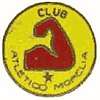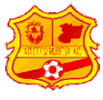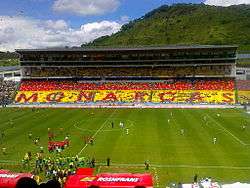Monarcas Morelia
Club Atlético Monarcas Morelia was a Mexican professional football club who was based in Morelia, Michoacán playing in Liga MX.[1] The club played their home games at Estadio Morelos.
 | ||||
| Full name | Club Atlético Monarcas Morelia | |||
|---|---|---|---|---|
| Nickname(s) | La Monarquía (The Monarchy) "Canarios" (Canaries) Los Purépechas (The Purépechas) | |||
| Founded | June 4, 1950 | |||
| Dissolved | June 2, 2020 | |||
| Ground | Estadio Morelos Morelia, Michoacán | |||
| Capacity | 35,000 | |||
|
| ||||
History
Beginnings
Club Atlético Morelia was founded November 21, 1924, as "Oro Morelia" in Morelia, Michoacán. In 1950, Club Deportivo Morelia was among the teams that founded the Segunda División. After the 1956–1957 season, in which they ended up in second place, they were officially promoted into the Primera División to replace Puebla. After an unsuccessful season, in 1968 Monarcas Morelia was relegated back to the Segunda División. During mixed 1968–1971 seasons, C.A. Morelia appointed Nicandro Ortiz as chairman. Ortiz acquired the team and strengthened its position in the league.
The 1978–1979 season thrust Morelia into contention for promotion; in 1980, Monarcas Morelia played under manager Diego Malta who helped his team towards the Mexico Championship and finally promotion to the Primera División in 1981.
In 1986 before the World Cup in Mexico Atletico Morelia played friendlies against Germany Losing 2-1 and against the URSS again losing 4-1.
In 1996 the major broadcast company TV Azteca bought the team. By the year 2000 the club were playing under the Monarcas moniker. In recent years Monarcas Morelia has been one of the main protagonists in the Primera División.
Although the team had played Mexican professional football for 70 years, it had never won a first division tournament until winter 2000, when the club raised the cup after beating Toluca on penalties. The team was crowned champions away in the Bombonera Stadium. The Morelos Stadium has never been the site of its team winning a final. On the day after the victory, a crowd that some estimate at 100 thousand people welcomed the team as it paraded along Morelia's main avenue, Avenida Madero on their way to the stadium where the crowd congregated as the team raised the cup and the fans congratulated the team for its first ever first division trophy.
After missing the playoffs for three consecutive tournaments, Morelia finished in third place in the general table in the Apertura 2009. Morelia defeated Santos Laguna in the first round, 4–2 on aggregate. Morelia was then defeated by Cruz Azul in a semi-final that was filled with controversy due to Cruz Azul player Joel Huiqui intentionally using his hand to hit the ball away and prevent Morelia midfielder Wilson Tíago from scoring. (Huiqui later played for Morelia.) With a 2–1 aggregate score, Morelia was eliminated. Morelia qualified for the 2010 Copa Libertadores by ending in third place in the classification phase. It was the second time that Morelia participated in the Copa Libertadores, the first being in 2002. Morelia was the Runner-up of the Clausura 2011, after a hard-fought final against Pumas. Pumas won the tie 3–2 on aggregate, taking the trophy home.
In 2010, Morelia became the SuperLiga champion, with a 2–1 victory in the finals over the New England Revolution in which Miguel Sabah scored both Morelia goals.
On November 5, 2013 Monarcas Morelia won their first Copa MX title in a 3–3 match that went to penalties, where they would take the victory. This title also allowed them to participate in the inaugural edition Supercopa MX, which they won against Tigres UANL with a global score of 5–4.
Relegation Struggles
After 15 years, a dismal 2014–15 campaign left Monarcas as one of the last teams in the relegation table, an aggregate of a club's most recent points totals that decides which teams will be relegated. As a result, Enrique Meza was chosen to be the coach for the Apertura 2015 season. Meza had already saved Morelia before, in the 1995–96 season. After no notable improvement in team performance, Meza was let go from the position of head coach in 2016, with Roberto Hernandez taking over as interim manager. Hernandez's tenure would coincide with the signing of Peruvian forward Raul Ruidiaz on loan from Universitario. The signing of Ruidiaz would prove to be crucial to the club's fortunes, as he would go on to score 20 goals throughout the 2016-2017 Liga MX season, finishing as top scorer with 11 goals in the Apertura and 9 goals in the Clausura. In the following season, Morelia was in danger of being relegated on the final match day of the Apertura, residing in last place in the relegation table and needing a victory over Monterrey to avoid the drop. Tied 1-1 in extra time, Raul Rudiaz scored a crucial winner that moved them out of the relegation zone, with Jaguares de Chiapas being relegated in their stead. Ruidiaz's goal additionally qualified them for that season's liguilla, its first since the 2016 Clausura.
Relocation
On May 23, 2020, various news outlets in Mexico reported the club would be relocating from Morelia to Mazatlán, Sinaloa.[2][3][4] The club's owner, Grupo Salinas, reportedly were asking for $400 million MXN per year from the Government of Michoacán to keep the team in the city.[5] The move was very unpopular among supporters, former players, and the sports media across Mexico.[6] Despite stay-at-home orders due to the COVID-19 pandemic, over 7,000 fans took to the streets of Morelia to protest the team's move.[7]
On June 2, 2020, the club and Liga MX announced the club's relocation to Mazatlán, just two days before the club's 70th anniversary.[8]
Badges
 First badge 1924–1972
First badge 1924–1972 Second badge 1973–1982
Second badge 1973–1982 Third badge 1983–1999
Third badge 1983–1999
Kit
The club's colors are generated from the city's flag which are yellow and red, which are the same colors in the Spanish flag, because the city is a novohispana city.
In the club's beginnings the club went under the name of Oro and were known as the canarios (canary) until 1999 when the club changed its name to Monarcas, due to the 3 monarchs found in the city's flag, which has been used from its foundation.
- First kit evolution 1924–1999[9]
|
1924
|
1951
|
1964
|
1979
|
1981
|
1986
|
|
1988
|
1992
|
1993
|
1995
|
1997
|
1998
|
|
2000
|
2002
|
2003
|
2004
|
2005
|
2006
|
2007
|
2011
|
Stadium

Towards the end of the 1980s it was decided that their stadium (Estadio Venustiano Carranza) was lacking capacity and that a new stadium with a greater number of seats needed to be constructed. On April 9, 1989, after several construction delays, Stadium Jose Maria Morelos and Pavón (located on the outskirts of the Quinceo mountain) was opened, and the inaugural game was between Atlético Morelia and Club América. The stadium has an official capacity of 45,000, although on inauguration in 1989 it is estimated that more than 50,000 were in attendance. Morelia won the match with the score 2–1. In 2011, the stadium was given a new look, seeing as the FIFA U-17 World Cup was taking place in Mexico.
Players

Morelia has had some notable players in their history. Marco Antonio Figueroa is the club's all-time leading scorer with 130 goals. Adolfo Bautista, Rafael Márquez Lugo, Moisés Muñoz, Miguel Sabah, Joel Huiqui, Adrián Aldrete, Enrique Pérez, Édgar Lugo and Elias Hernandez, are some of the players that were called up to the Mexico national team while playing with the team. Raul Ruidiaz was the first Morelia player to achieve a Liga MX top scoring title.
Top Goalscorers
| Monarcas Morelia | ||||
|---|---|---|---|---|
| Rank | Player | Goals | ||
| 1 | 130 Goals | |||
| 2 | 71 Goals | |||
| 3 | 64 Goals | |||
| 4 | 59 Goals | |||
| 5 | 58 Goals | |||
- Players in bold are currently active with Monarcas Morelia.
- Players in italic are still active but are not currently with Monarcas Morelia.
- Does not include international competition goals.
Honours
Domestic
- Liga MX: 1
- Invierno 2000
- Runner-up (3): Apertura 2002, Clausura 2003, Clausura 2011
- Segunda Division: 1
- 1981
- Copa MX: 1
- Apertura 2013
- Runner-up (1): 1964–65, Clausura 2017
- Supercopa MX: 1
Managers
|
|
|
![]()
References
- http://www.soccerbox.com/blog/monarcas-morelia-an-overview/
- https://www.mediotiempo.com/futbol/liga-mx/morelia-seria-el-equipo-que-emigre-a-la-nueva-sede-en-mazatlan
- https://www.marca.com/claro-mx/futbol/liga-mx/2020/05/24/5eca00de46163f091d8b45ac.html
- https://espndeportes.espn.com/futbol/mexico/nota/_/id/6973715/morelia-mudanza-mazatlan-jorge-valdivia-mensaje-twitter
- https://www.mediotiempo.com/futbol/liga-mx/gobierno-michoacan-descarta-rescate-financiero-monarcas-morelia
- https://mexico.as.com/mexico/2020/06/02/futbol/1591120419_580560.html
- https://espndeportes.espn.com/futbol/mexico/nota/_/id/6998831/morelia-marcha-aficionados-convoca-miles-personas-mudanza-mazatlan
- https://www.espn.com/soccer/mexican-liga-bbva-mx/story/4105489/liga-mx-club-morelia-moves-to-mazatlan
- "Monarcas Morelia Football Jerseys". oldfootballshirts.com. Retrieved 27 July 2012.